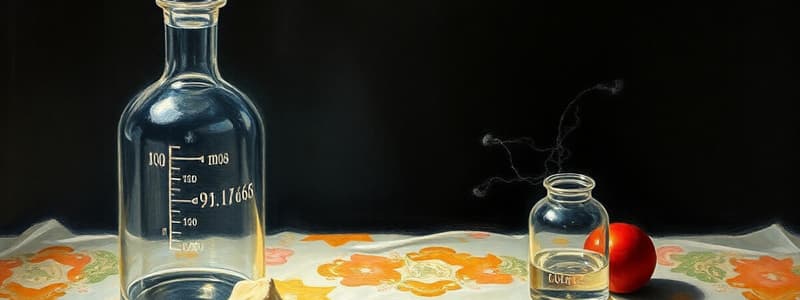Podcast
Questions and Answers
Which of the following statements about atoms is correct?
Which of the following statements about atoms is correct?
- Atoms are made of protons, electrons, and molecules.
- Protons are positively charged and found in the nucleus. (correct)
- Neutrons carry a positive charge and are smaller than protons.
- Electrons are found in the nucleus and have a positive charge.
What does the atomic mass of an element represent?
What does the atomic mass of an element represent?
- The weight of the electrons in the atom.
- The number of protons in an atom.
- The total number of electrons in the atom.
- The sum of protons and neutrons in the nucleus. (correct)
If an atom loses an electron, it becomes which of the following?
If an atom loses an electron, it becomes which of the following?
- A different element.
- A compound.
- An isotope.
- An ion. (correct)
What characterizes a covalent bond between atoms?
What characterizes a covalent bond between atoms?
In a stable atom, the number of protons is equal to what?
In a stable atom, the number of protons is equal to what?
What defines an isotope of an element?
What defines an isotope of an element?
What does the pH scale measure?
What does the pH scale measure?
Which of the following is a correct characteristic of ionic bonds?
Which of the following is a correct characteristic of ionic bonds?
Which of the following compounds is formed through covalent bonding?
Which of the following compounds is formed through covalent bonding?
If a solution has a pH of 8, it is considered to be what?
If a solution has a pH of 8, it is considered to be what?
What happens to an atom when the number of protons changes?
What happens to an atom when the number of protons changes?
How can you determine the number of neutrons in an atom if given its atomic number and atomic mass?
How can you determine the number of neutrons in an atom if given its atomic number and atomic mass?
Which of the following statements is true about ions?
Which of the following statements is true about ions?
What distinguishes a compound from an element?
What distinguishes a compound from an element?
Which of the following is an example of a compound?
Which of the following is an example of a compound?
Which of the following best describes the pH scale?
Which of the following best describes the pH scale?
What is the smallest functional unit of a compound?
What is the smallest functional unit of a compound?
Which statement correctly differentiates ionic and covalent bonds?
Which statement correctly differentiates ionic and covalent bonds?
How is the atomic mass of an element determined?
How is the atomic mass of an element determined?
Which statement is true regarding isotopes?
Which statement is true regarding isotopes?
Flashcards
Element
Element
The simplest form of matter that cannot be broken down into simpler substances.
Periodic Table
Periodic Table
A table that organizes all known elements.
Atom
Atom
The smallest unit of an element.
Proton
Proton
Signup and view all the flashcards
Neutron
Neutron
Signup and view all the flashcards
Electron
Electron
Signup and view all the flashcards
Atomic Number
Atomic Number
Signup and view all the flashcards
Atomic Mass
Atomic Mass
Signup and view all the flashcards
Ion
Ion
Signup and view all the flashcards
Isotope
Isotope
Signup and view all the flashcards
Compound
Compound
Signup and view all the flashcards
Ionic Bond
Ionic Bond
Signup and view all the flashcards
Covalent Bond
Covalent Bond
Signup and view all the flashcards
Molecule
Molecule
Signup and view all the flashcards
pH Scale
pH Scale
Signup and view all the flashcards
Element
Element
Signup and view all the flashcards
Atom
Atom
Signup and view all the flashcards
Proton
Proton
Signup and view all the flashcards
Neutron
Neutron
Signup and view all the flashcards
Electron
Electron
Signup and view all the flashcards
Atomic Number
Atomic Number
Signup and view all the flashcards
Atomic Mass
Atomic Mass
Signup and view all the flashcards
Ion
Ion
Signup and view all the flashcards
Isotope
Isotope
Signup and view all the flashcards
Compound
Compound
Signup and view all the flashcards
Ionic Bond
Ionic Bond
Signup and view all the flashcards
Covalent Bond
Covalent Bond
Signup and view all the flashcards
Molecule
Molecule
Signup and view all the flashcards
pH Scale
pH Scale
Signup and view all the flashcards
Study Notes
Basic Chemistry
- Elements are the simplest form of matter, indivisible into simpler substances.
- The periodic table lists 120 known elements, each with a unique symbol (e.g., gold = Au).
- Elements are composed of atoms.
- Atoms consist of:
- Protons: Positively charged, located in the nucleus.
- Neutrons: No charge, located in the nucleus, similar size to protons.
- Electrons: Negatively charged, orbit the nucleus.
- Atomic Number: The number above the element symbol, representing the number of protons. In a stable atom, it also equals the number of electrons.
- Atomic Mass: The number below the element symbol, representing the total number of protons and neutrons.
- To find the number of neutrons, subtract the atomic number from the atomic mass.
- Changing the number of electrons changes the charge of an atom (forming an ion), but not the element.
- Changing the number of protons changes the type of element.
- Changing the number of neutrons creates an isotope, which is often unstable and radioactive.
- Compounds are formed by combining two or more elements (e.g., H₂O, CO₂, NaCl).
- Compounds bond through different types:
- Ionic bonds: One atom donates an electron to another (example: NaCl).
- Covalent bonds: Atoms share electrons (example: CH₄).
- Molecules are the smallest functional units of compounds (e.g., a single H₂O molecule).
- pH scale measures free hydrogen ions in a solution.
- pH 7 is neutral.
- pH < 7 is acidic.
- pH > 7 is basic (alkaline).
- Each whole number change on the pH scale represents a 10-fold difference in acidity or basicity (e.g., pH 4 is 10 times more acidic than pH 5).
Studying That Suits You
Use AI to generate personalized quizzes and flashcards to suit your learning preferences.




